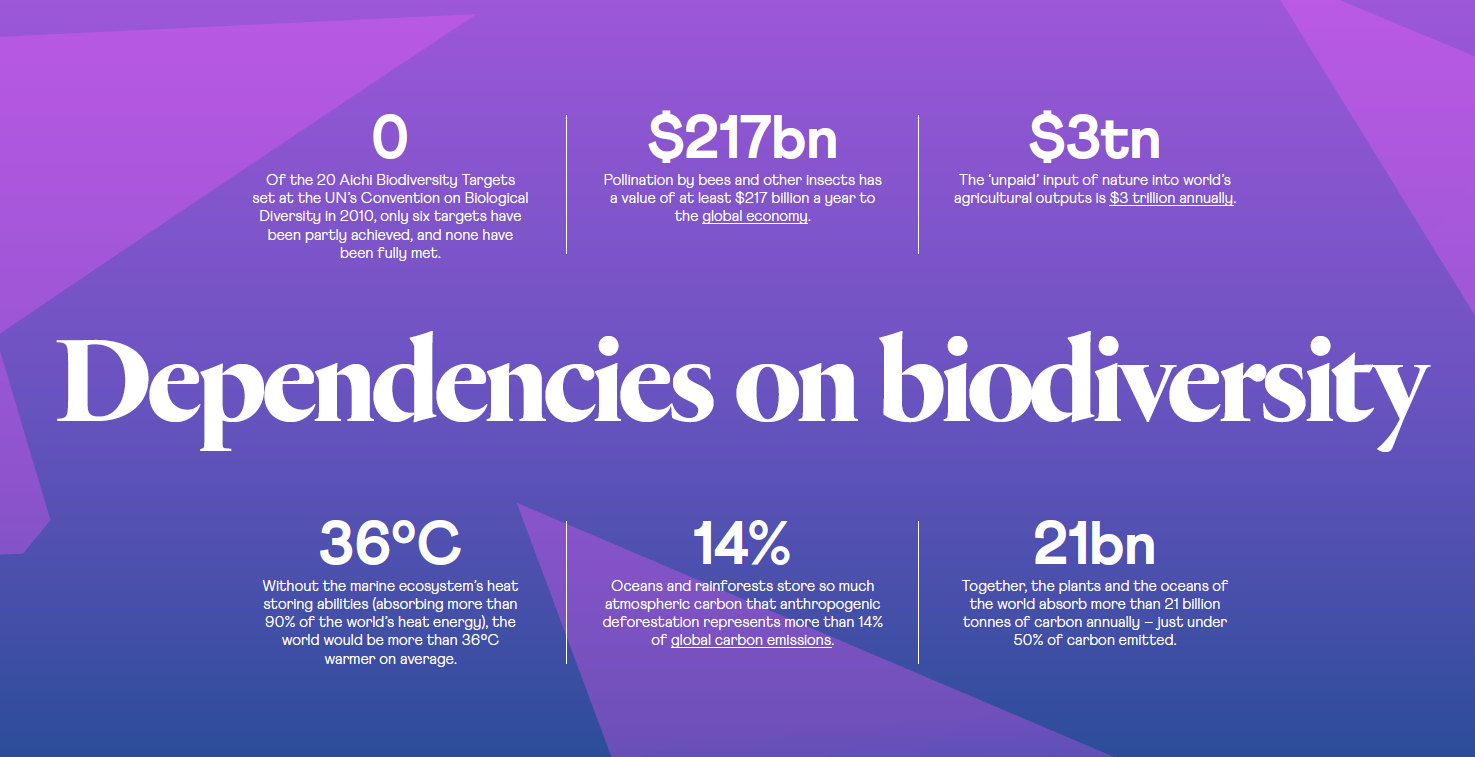
Stay informed with regulations, insights & events by joining our mailer
Biodiversity
Definition:
/ˌbʌɪə(ʊ)dʌɪˈvəːsɪti/
noun: biodiversity; noun: bio-diversity
The variety of plant and animal life in the world or in a particular habitat, a high level of which is usually considered to be important and desirable.1
We all depend on biodiversity to support our wellbeing, our wealth and ultimately our existence. Plants and animals are the lifeblood of the ecosystems that give us the resources, like food and materials, and the services, such as pollination, clean air and water, we need to survive. Most businesses rely on a thriving natural environment.
Which is why at Ever we are eagerly awaiting the next iteration of the beta framework from the Taskforce on Nature-related Financial Disclosures (TNFD) later this month (which will dig into metrics) and the publication of the final framework in June 2023.
Back in 2021 we launched our research paper, Uncovering Nature and Biodiversity, with the aim of supporting our clients to better understand and reflect on the nature-related risks inherent in their business operations, and to build this into robust and value-creating sustainability strategies.
We anticipate TNFD will be a powerful tool helping business and finance integrate nature into decision making so action can be taken on nature-related dependencies, impacts, risks and opportunities, sooner rather than later. Its alignment with the approach and language of TCFD and attempts to accommodate the varying materiality and reporting preference aims should help increase and improve disclosure over time.
Why it matters
$44 trillion worth of assets are dependent on nature and biodiversity – more than 50% of global GDP.2
World Economic Forum
70%
Almost 70% of mammals, birds, fish and reptiles have been wiped out since 19703. The impacts of this, combined with the effects of climate change, are becoming clear, in the form of devastating floods, dangerously low bee populations and desertification.
1.5oC
As well as securing ongoing access to the resources we need, protecting and restoring biodiversity will play an important part in helping us adapt to the impacts of climate change. The carbon storage capacity of forests, mangroves and oceans will be vital in meeting the Paris Agreement goal of limiting warming to 1.5oC.
What is changing?
Impact at this scale has led to urgent action at intergovernmental, national government and non-governmental levels, including a raft of policy, regulations and disclosure frameworks to help organisations play their part in protecting biodiversity in their value chains.
In December 2022, the 15th Conference of Parties to the UN Convention on Biological Diversity adopted the “Kunming-Montreal Global Biodiversity Framework” (GBF), including four goals and 23 targets for achievement by 2030. The GBF aims to address biodiversity loss, restore ecosystems and protect indigenous rights. It includes concrete measures to halt and reverse nature loss, including putting 30% of the planet and 30% of degraded ecosystems under protection by 2030.
At the EU level, biodiversity is protected under the Green Deal framework which includes a standalone biodiversity strategy. In the UK, new Biodiversity Net Gain regulations come into force in November 2023 covering building development and/or land management. The approach aims to leave the natural environment in a measurably better state than it was beforehand.
Some financial institutions are playing an influential role in protecting and restoring biodiversity by adopting policies to ensure they invest or offer access to finance only to those organisations that are taking action on biodiversity in their value chains.
14%
Oceans and rainforests store so much atmospheric carbon that anthropogenic deforestation represents more than 14% of global carbon emissions.4
36oC
Without the marine ecosystem’s heat storing abilities (absorbing more than 90% of the world’s heat energy), the world would be more than 36°C warmer on average.5
What can you do?
As part of their approach to climate strategy, value creation and access to finance, businesses are beginning to take a systematic approach to protecting and restoring biodiversity.
V0.4 of the TNFD beta risk management and disclosure framework is expected to be out for market consultation in March 2023 and the final framework is expected to be published in June.
Free biodiversity health check
In the meantime, the Ever team is offering a free biodiversity health check to help you understand your impacts and spot opportunities for integrating biodiversity into your wider sustainability agenda and stakeholder engagement.
For your free biodiversity health check, email team@eversustainable.co.uk
Sources
1 Definition from Oxford Languages
2 World Economic Forum in collaboration with PwC Nature Risk Rising: Why the Crisis Engulfing Nature Matters for Business and the Economy https://www3.weforum.org/docs/WEF_New_Nature_Economy_Report_2020.pdf
3 WWF (2022) Living Planet Report 2022 – Building a nature-positive society. Almond, R.E.A., Grooten, M., Juffe Bignoli, D. & Petersen, T. (Eds). WWF, Gland, Switzerland. https://www.wwf.org.uk/sites/default/files/2022-10/lpr_2022_full_report.pdf

